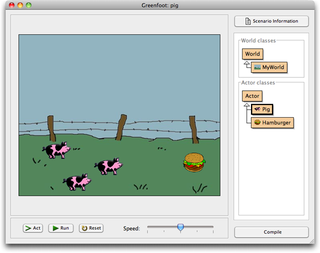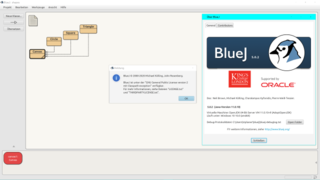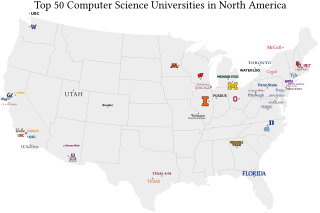ASSIST is an IBM System/370-compatible assembler and interpreter developed in the early 1970s at Penn State University by Graham Campbell and John Mashey along with student assistants.
A pedagogical pattern is the re-usable form of a solution to a problem or task in pedagogy, analogous to how a design pattern is the re-usable form of a solution to a design problem. Pedagogical patterns are used to document and share best practices of teaching. A network of interrelated pedagogical patterns is an example of a pattern language.

Peter James Denning is an American computer scientist and writer. He is best known for pioneering work in virtual memory, especially for inventing the working-set model for program behavior, which addressed thrashing in operating systems and became the reference standard for all memory management policies. He is also known for his works on principles of operating systems, operational analysis of queueing network systems, design and implementation of CSNET, the ACM digital library, and codifying the great principles of computing. He has written numerous influential articles and books, including an overview of fundamental computer science principles, computational thinking, and his thoughts on innovation as a set of learnable practices.

BlueJ is an integrated development environment (IDE) for the Java programming language, developed mainly for educational purposes, but also suitable for small-scale software development. It runs with the help of Java Development Kit (JDK).

Greenfoot is an integrated development environment using Java or Stride designed primarily for educational purposes at the high school and undergraduate level. It allows easy development of two-dimensional graphical applications, such as simulations and interactive games.

David Gries is an American computer scientist at Cornell University, mainly known for his books The Science of Programming (1981) and A Logical Approach to Discrete Math.

Michael Kölling is a German computer scientist, currently working at King's College London, best known for the development of the BlueJ and Greenfoot educational development environments and as author of introductory programming textbooks. In 2013 he received the SIGCSE Award for Outstanding Contribution to Computer Science Education for the development of the BlueJ.

Mark Joseph Guzdial is a Professor in the College of Engineering at the University of Michigan. He was formerly a professor in the School of Interactive Computing at the Georgia Institute of Technology affiliated with the College of Computing and the GVU Center. He has conducted research in the fields of computer science education and the learning sciences and internationally in the field of Information Technology. From 2001–2003, he was selected to be an ACM Distinguished Lecturer, and in 2007 he was appointed Vice-Chair of the ACM Education Board Council. He was the original developer of the CoWeb, one of the earliest wiki engines, which was implemented in Squeak and has been in use at institutions of higher education since 1998. He is the inventor of the Media Computation approach to learning introductory computing, which uses contextualized computing education to attract and retain students.
Computational thinking (CT) refers to the thought processes involved in formulating problems so their solutions can be represented as computational steps and algorithms. In education, CT is a set of problem-solving methods that involve expressing problems and their solutions in ways that a computer could also execute. It involves automation of processes, but also using computing to explore, analyze, and understand processes.

Computer science education or computing education is the field of teaching and learning the discipline of computer science, and computational thinking. The field of computer science education encompasses a wide range of topics, from basic programming skills to advanced algorithm design and data analysis. It is a rapidly growing field that is essential to preparing students for careers in the technology industry and other fields that require computational skills.
Explicit Multi-Threading (XMT) is a computer science paradigm for building and programming parallel computers designed around the parallel random-access machine (PRAM) parallel computational model. A more direct explanation of XMT starts with the rudimentary abstraction that made serial computing simple: that any single instruction available for execution in a serial program executes immediately. A consequence of this abstraction is a step-by-step (inductive) explication of the instruction available next for execution. The rudimentary parallel abstraction behind XMT, dubbed Immediate Concurrent Execution (ICE) in Vishkin (2011), is that indefinitely many instructions available for concurrent execution execute immediately. A consequence of ICE is a step-by-step (inductive) explication of the instructions available next for concurrent execution. Moving beyond the serial von Neumann computer, the aspiration of XMT is that computer science will again be able to augment mathematical induction with a simple one-line computing abstraction.
Owen Astrachan is an American computer scientist and professor of the practice of computer science at Duke University, where he is also the department's director of undergraduate studies. He is known for his work in curriculum development and methods of teaching computer science. He was one of the first National Science Foundation CISE Distinguished Education Fellows, and is a recipient of the ACM Outstanding Educator Award. He was the principal investigator on the multi-year NSF/College Board project that led to the release of the AP Computer Science Principles course and exam.
Joyce Currie Little was an American computer scientist, engineer, and educator. She was a professor and chairperson in the Department of Computer and Information Sciences at Towson University in Towson, Maryland.
Susan Beth Horwitz was an American computer scientist noted for her research on programming languages and software engineering, and in particular on program slicing and dataflow-analysis. She had several best paper and an impact paper award mentioned below under awards.

David Jay Malan is an American computer scientist and professor. Malan is a Gordon McKay Professor of Computer Science at Harvard University, and is best known for teaching the course CS50, which is the largest open-learning course at Harvard University and Yale University and the largest Massive Open Online Course (MOOC) at EdX, with lectures being viewed by over a million people on the edX platform up to 2017.
Valerie Barr is an American computer scientist, and is the Margaret Hamilton Distinguished Professor of Computer Science at Bard College. She formerly held the Jean Sammet endowed chair in the department of Computer Science at Mount Holyoke College in South Hadley, Massachusetts. She is known for her work with women in computing.
Daniel Zingaro is an associate professor at the University of Toronto Mississauga. His main areas of research are in evaluating Computer science education and online learning. He has co-authored over 80 articles in peer-reviewed journals and conferences; and also authored a textbook, "Invariants: a Generative Approach to Programming.
The Outstanding Contribution to Computer Science Education award is a prize granted by the Association for Computing Machinery (ACM) Special Interest Group (SIG) on Computer science education (SIGCSE). Outstanding contributions can include curriculum design, innovative teaching methods, authorship of textbooks, and the development of novel teaching tools. The award has been granted annually since 1981. The SIGCSE website contains more information about the awardees.
Parsons problems are a form of an objective assessment in which respondents are asked to choose from a selection of code fragments, some subset of which comprise the problem solution. The Parsons problem format is used in the learning and teaching of computer programming.
The International Bebras Challenge on Informatics is an annual computer science competition for primary and secondary school students around the world. With 93 member countries and more than 2.5 million participating students in 2024, the competition is the largest computer science competition in the world. The Bebras competition adds new countries every year.








